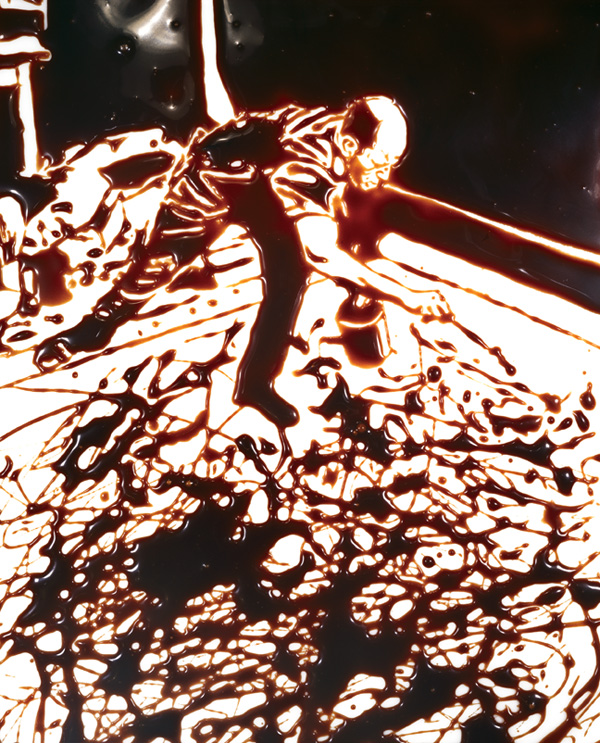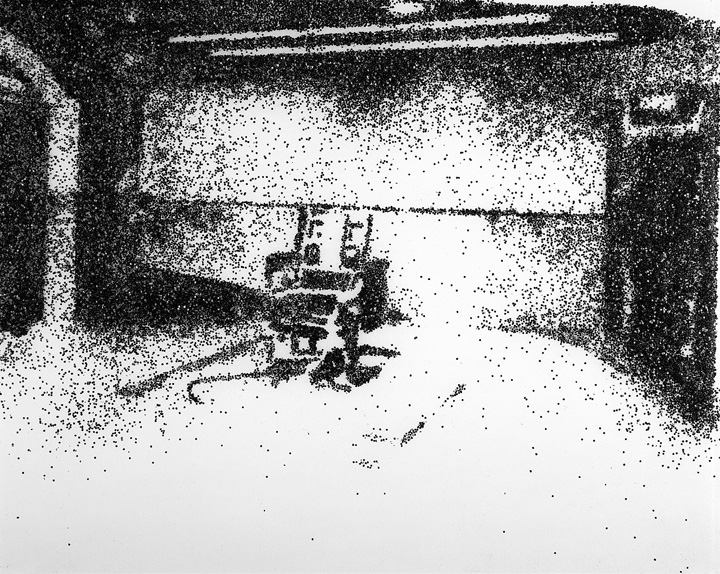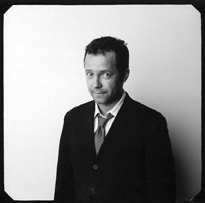[Fall 2007]
by Jean-François Bélisle
Jean-François Bélisle : Let’s start with the materials you use. They have been described as unconventional. Soil, chocolate, ashes, thread, sugar, wires, nails – you seem to have tried everything! How do you choose those materials, and what links them to the subject matter that you depict with them?
Vik Muniz : When you stop to think about what the word “material” means, the whole idea of what is conventional or unconventional collapses into a single, simple notion: Material is material, something that invariably has been extracted from the earth, has grown from the earth, or is taken from an animal that fed from the earth. Everything else is what our cognitive, creative, and cultural tools aggregate to material. So, what is an unconventional material? Eighteenth-century painters used stuff like mummy powder to get deep brownish greys. What about rabbit glue, bee’s wax or banana oil? A former mayor of New York once made such a fuss about an English painter who used elephant dung to portray the Virgin Mary. Had he ever seen or smelled elephant dung? Did he know that people in Africa and Asia make houses, light fires, and even portray their religious icons with it? Another famous case was that of an American artist who showed a photograph of a crucifix immersed in something he described as urine. Both cases propelled these artists’ rather sophomoric conceptual game to the mainstream of cultural discussion, revealing more about our ignorance about representation than their understanding of it. When I pick a material to work with, I am always aware of the conceptual disparity between it and the image I want to portray, but instead of making a statement (I hate art that makes statements) I create a situation in which both material and image have to be negotiated.
JFB : So does this play into your choice to display photos of these materials rather than the actual objects? The models you create are stunning. Do you think they could be presented as artworks?
VM : Photography creates a veil of ambiguity that makes the viewer more interested in the process. Whenever I think of what photography does to the model, I think of lacy lingerie: nudity is natural and often boring, but if you cover it with an infinite number of peepholes sewn together, it becomes mysterious and symbolic. In art, there is always a need to emphasize what you can’t see or know in order to keep the viewer’s attention alive and focused. You can walk around a sculpture and see it from all sides. A photograph of a sculpture reveals only a particular vantage point, a moment when that object was perceived, a place, a choice. You need that specificity and that narrative to have a conversation with the image. The beautiful thing about photography is its superficiality and its power to communicate and conceal things through this very topical layer of meaning.
JFB : But in your works, what composes the images is not always concealed. In your 2006 series Pictures of Junk, the individual elements used to “reproduce” the paintings by such old masters as Goya, Caravaggio, and Correggio are clearly identifiable. Could you expand on the nature of illusionism in your work and the importance of the scales you use?
VM : If we rightfully define illusionism as the ability of making someone see something in something else, the definition of illusionistic art would encompass the entire history of art all the way to Lescaux or Altamira. As a matter of fact, the whole business of language and, therefore, theatre, politics, religion, commerce, family, and society depends on symbolic exchange, which is by nature illusionistic. The hardest thing is to admit that you can’t explain illusion without using it. I am not discrediting the whole business of philosophy, but, at least in my view, one can understand more about language from reading James Joyce than by memorizing all of Sausurre or Derrida on the subject. Nobody will learn about food from reading cookbooks or how to swim by watching the Olympics. Illusion and humour are serious subjects because they speak about the logical structures that make our existence possible. In one’s ability to subvert these structures lies the secret of how to keep them alive. What differentiates art from philosophy is that we are trying to make the bed while still inside it. We have to generate knowledge from interaction, experience, yes, illusion and humour, our tools, and, of course, a hell of a lot of honesty.
Your question has also somehow taken me to nineteenth-century Egypt. Luxor, to be precise, where a young Maxime DuCamp feels he needs to place an assistant next to each monumental sculpture he photographs in order to convey the sheer magnitude of the ancient city. I have always been tempted to re-create models of Luxor and use dolls to convey the scale so the viewer would be more interested in knowing the size of the doll than of the monument. This body of work would be a perfect answer to the second part of your question. Archaeologists often use pound coins or quarters to show the size of the fossils they find in pictures. It’s not that they don’t have rulers – it’s the fact that we are more familiar with coins than inches or centimetres. The value of the coin then becomes a measuring device. When one looks at a picture, one is always scanning for clues such as size, time, speed, location, and so on. In my experience, size is the key cognitive device in a picture. I love to place viewers in this Alice in Wonderland antechamber – the doors are too small, the cup is too big kind of thing – so they will be forced to devise a way out of the picture other than turning their back to it.
I have worked on land drawings over a mile long that, once photographed, became little pictures, and photographed drawings of castles made on a grain of sand that turned out to be pretty big. It’s great to watch the viewers trace the process that created those scale shifts in their heads while looking at the pictures. One can’t truly enjoy a picture without having to think about it.
JFB : And in your case, thinking about the work implies thinking about how it was done. Am I right in assuming that it is important for you to keep traces of the production process identifiable within the illusions?
VM : In order to create an illusion and talk about it at the same time, one has to leave a trail of breadcrumbs behind. I chose to work on the opposite end of illusion, at its more primitive and precarious level, where it borders what we consider to be reality. Bad illusions don’t really fool us as much as they demonstrate our desire, predisposition, and need to be fooled. These simpler illusions are more relevant since viewers, instead of being amazed by the technique or technology that fooled them, will be impressed by their own ingenuity and naiveté. I have always said that Stanislaviskian theatre delivers you the character and Brechtian theatre the actor, but only really bad theatre can deliver you both simultaneously. I want the viewer to follow my steps as I went about making the picture, so I make it simple, sometimes even crude.
My job as an artist is to test the validity of illusions and expose their after effects, to build a very wobbly bridge between image and object.
JFB : Showing the production process greatly differentiates your work from most constructed images. The theme of this issue of ciel variable is cultural tourism, a sphere where constructed images abound. Have you ever been interested in the illusions of the tourist industry?
VM : I am what one might call a “wall artist,” the kind who relies on the ritual narrative of viewers physically and willingly encountering the images I make. My work can’t be fully represented in print, on video, or on a computer screen. It has a size, material composition, and level of detail that can be experienced only as you walk toward it and gain knowledge about it. This physical dependence makes most “wall art” similar to tourist attractions, except that exhibitions travel as much as dedicated viewers. Tourism has a lot to do with being able to tell people that you’ve seen with your own eyes what most have experienced through glossy reproductions. To travel from Europe to experience Picasso and Matisse in New York sounds twice as glamorous. What is most interesting about the whole business of physically experiencing what you only knew from representations is the adaptation from image to reality. I don’t know how many times I’ve seen a TV personality on the street and greeted the person as if I had known him or her intimately for most of my life – only to feel embarrassed and stupid a second later. Matching the holographic complexity of reality with the synthetic, superficial, fake familiarity that images provide is no easy task for the narcissistic intellectual. This somehow explains the squinty, confused expressions as tourists shift back and forth between the Temple of Angkor Wat and illustrations of it in their guidebooks. That’s why they take pictures that could only be worse than the ones in the guidebooks – to later compare their images to those they have seen before. Their flash-glared snapshot of the Mona Lisa is like the initials they could not carve in the picture with a Swiss army knife. The longing for conquering the world with experience can be sedated only by images. There is a powerful drug industry behind these sedatives that are designed to sell their remedies as food. My job as an artist is to test their validity and expose their after effects, to build a very wobbly bridge between image and object, and to emphasize the fact that real experience can exist only in that fraction of a second when the eye travels from the real Angkor Wat to its picture in the guide book.
Jean-François Bélisle is an independent critic and curator. He recently curated and wrote catalogue essays on Lynne Cohen, Denis Farley, and Jean McEwen, as well as articles on the Venice Biennale and the Whitney Biennial.



